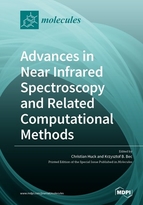Advances in Near Infrared Spectroscopy and Related Computational Methods
A special issue of Molecules (ISSN 1420-3049). This special issue belongs to the section "Analytical Chemistry".
Deadline for manuscript submissions: closed (30 June 2019) | Viewed by 126925
Special Issue Editors
Interests: vibrational spectroscopy; separation science; enrichment techniques; mass spectrometry
Special Issues, Collections and Topics in MDPI journals
Interests: molecular spectroscopy; analytical chemistry; natural product analysis; physical chemistry; chemometrics
Special Issues, Collections and Topics in MDPI journals
Special Issue Information
Dear Colleagues,
In the last few decades, near-infrared (NIR) spectroscopy has distinguished itself as one of the most rapidly advancing spectroscopic techniques. Mainly known as an analytical tool useful for sample characterization and content quantification, NIR spectroscopy is essential in various other fields, e.g., NIR imaging techniques in biophotonics, medical applications or used for characterization of food products, to name the few. Its contribution in basic science and physical chemistry should be noted as well, i.e., in exploration of the nature of molecular vibrations or intermolecular interactions. One of the current development trends involves the miniaturization and simplification of instrumentation, creating prospects for the spread of NIR spectrometers at a consumer level, i.e., in the form of smartphone attachments—a breakthrough not yet accomplished by any other analytical technique. NIR spectroscopy has been developing in conjunction with advanced methods of data analysis; recent years have highlighted the role of anharmonic quantum mechanical computations in shedding light on the complex nature of NIR spectra as well.
The importance of NIR spectroscopy is well demonstrated by a remarkable amount of highly appealing scientific papers being published every year. At the same time, a growing diversity in the related methods and applications has led to a dispersion of these contributions among disparate scientific communities. For this reason, we see a need to create the present Special Issue with aim to bring together these communities which may be perceiving NIR spectroscopy from different perspectives.
For the readership, this Special Issue will provide a remarkable opportunity to obtain more easily an overview of state-of-the-art NIR spectroscopy, its history, current development trends and future prospects. For the authors, it will offer an appropriate occasion to make their results and techniques more visible, and to present the most recent accomplishments in their respective fields which have become possible with the use of NIR spectroscopy. This Special Issue will contain contributions discussing all the mentioned aspects in a broad context of NIR spectroscopy and the relevant computational methods. Review articles by experts in the field will also be welcome.
Besides, research topics not directly focused on near-infrared region, which however remain relevant by employing the methodologies essential in near-infrared spectroscopy are also welcome. This includes but is not limited to, e.g. anharmonic quantum mechanical methods, spectra simulation, hyper-spectral imaging techniques, spectral image processing, spectral data analysis, chemometrics.
Prof. Dr. Christian Huck
Dr. Krzysztof B. Bec
Guest Editors
Manuscript Submission Information
Manuscripts should be submitted online at www.mdpi.com by registering and logging in to this website. Once you are registered, click here to go to the submission form. Manuscripts can be submitted until the deadline. All submissions that pass pre-check are peer-reviewed. Accepted papers will be published continuously in the journal (as soon as accepted) and will be listed together on the special issue website. Research articles, review articles as well as short communications are invited. For planned papers, a title and short abstract (about 100 words) can be sent to the Editorial Office for announcement on this website.
Submitted manuscripts should not have been published previously, nor be under consideration for publication elsewhere (except conference proceedings papers). All manuscripts are thoroughly refereed through a single-blind peer-review process. A guide for authors and other relevant information for submission of manuscripts is available on the Instructions for Authors page. Molecules is an international peer-reviewed open access semimonthly journal published by MDPI.
Please visit the Instructions for Authors page before submitting a manuscript. The Article Processing Charge (APC) for publication in this open access journal is 2700 CHF (Swiss Francs). Submitted papers should be well formatted and use good English. Authors may use MDPI's English editing service prior to publication or during author revisions.
Keywords
- near-infrared spectroscopy (NIRS)
- analytical spectroscopy
- NIR imaging/mapping
- hyperspectral image processing
- hand-held/portable spectrometers
- chemometrics and data analysis
- theoretical spectroscopy
- spectra simulation








